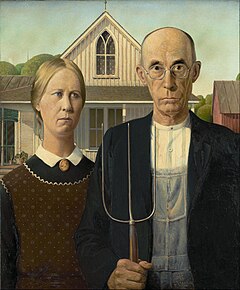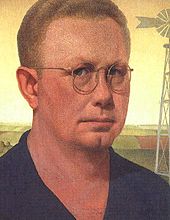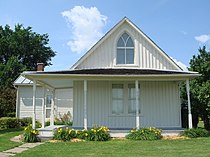This article is about the painting. For other uses, see American Gothic (disambiguation).
| American Gothic | |
|---|---|
 | |
| Artist | Grant Wood |
| Year | 1930 |
| Type | Oil on beaverboard |
| Dimensions | 78 cm × 65.3 cm (30+3⁄4 in × 25+3⁄4 in) |
| Location | Art Institute of Chicago, Chicago |
American Gothic is a 1930 oil on beaverwood painting by the American Regionalist artist Grant Wood. Depicting a Midwestern farmer and his daughter standing in front of their Carpenter Gothic style home, American Gothic is one of the most famous American paintings of the 20th century and is frequently referenced in popular culture.
Wood was inspired to paint what is now known as the American Gothic House in Eldon, Iowa, along with "the kind of people fancied should live in that house".
The figures were modeled after Wood's sister Nan Wood Graham and Byron McKeeby, the Wood family's dentist. The woman is dressed in a colonial print apron evoking 20th-century rural Americana while the man is adorned in overalls covered by a suit jacket and carries a pitchfork. The plants on the porch of the house are mother-in-law's tongue and beefsteak begonia, which also appear in Wood's 1929 portrait of his mother, Woman with Plants.
From 2016 to 2017, the painting was displayed in Paris at the Musée de l'Orangerie and in London at the Royal Academy of Arts, in its first showings outside the United States. The painting is currently displayed at the Art Institute of Chicago.
Creation

In August 1930, Grant Wood, an American painter with European training, was driven around Eldon, Iowa, by a young local painter named John Sharp. Looking for inspiration, he noticed the Dibble House, a small white house built in the Carpenter Gothic architectural style. Sharp's brother suggested in 1973 that it was on this drive that Wood first sketched the house on the back of an envelope. Wood's earliest biographer, Darrell Garwood, noted that Wood "thought it a form of borrowed pretentiousness, a structural absurdity, to put a Gothic-style window in such a flimsy frame house".

At the time, Wood classified it as one of the "cardboardy frame houses on Iowa farms" and considered it "very paintable". After obtaining permission from the house's owners, Selma Jones-Johnston and her family, Wood made a sketch the next day in oil paint on paperboard from the front yard. This sketch depicted a steeper roof and a longer window with a more pronounced ogive than on the actual house – features which eventually adorned the final work.
Wood decided to paint the house along with, in his words, "the kind of people fancied should live in that house". He recruited his sister, Nan (1899–1990), to be the model for the daughter, dressing her in a colonial-print apron mimicking 20th-century rural Americana. While preparing for the painting, Wood requested that she make the apron herself and include rickrack trim to better reflect the time period. As rickrack was no longer available in stores, Nan removed trim from their mother Hattie's old dresses to apply to the apron. The model for the father was the Wood family's dentist, Dr. Byron McKeeby (1867–1950) from Cedar Rapids, Iowa. Nan told people that her brother had envisioned the pair as father and daughter, not husband and wife, which Wood himself confirmed in his letter to a Mrs. Nellie Sudduth in 1941: "The prim lady with him is his grown-up daughter."
Elements of the painting stress the vertical that is associated with Gothic architecture. The upright, three-pronged pitchfork is echoed in the stitching of the man's overalls and shirt, the Gothic pointed-arch window of the house under the steeped roof, and the structure of the man's face. However, Wood did not add figures to his sketch until he returned to his studio in Cedar Rapids. Moreover, he would not return to Eldon again, although he did request a photograph of the home to complete his painting.
Reception and interpretation
Wood entered the painting in a competition at the Art Institute of Chicago. One judge deemed it a "comic valentine", but a museum patron persuaded the jury to award the painting the bronze medal and a $300 cash prize. The same patron also persuaded the Art Institute to buy the painting, and it remains part of the Chicago museum's collection. The image soon began to be reproduced in newspapers, first by the Chicago Evening Post, and then in New York, Boston, Kansas City, and Indianapolis. However, when the image finally appeared in the Cedar Rapids Gazette, there was a backlash. Iowans were furious at their depiction as "pinched, grim-faced, puritanical Bible-thumpers". Wood protested, saying that he had not painted a caricature of Iowans, but rather a depiction of his appreciation, stating "I had to go to France to appreciate Iowa." In a 1941 letter, Wood said that, "In general, I have found, the people who resent the painting are those who feel that they themselves resemble the portrayal."
Art critics who had favorable opinions about the painting, such as Gertrude Stein and Christopher Morley, similarly assumed the painting was meant to be a satire of rural small-town life. It was thus seen as part of the trend toward increasingly critical depictions of rural America along the lines of, in literature, Sherwood Anderson's 1919 novel Winesburg, Ohio, Sinclair Lewis's 1920 Main Street, and Carl Van Vechten's 1924 The Tattooed Countess.
However, with the deepening of the Great Depression not too long after the painting was made, American Gothic came to be seen as a depiction of the steadfast American pioneer spirit. Wood assisted this interpretive transition by renouncing his bohemian youth in Paris and grouping himself with populist Midwestern painters such as John Steuart Curry and Thomas Hart Benton, who revolted against the dominance of East Coast art circles. Wood was quoted in this period as stating, "All the good ideas I've ever had came to me while I was milking a cow." Wood intended the painting to depict the farmer and his daughter as survivors, to pay homage to the strength of the rural community, and to provide reassurance in a time of great economic upset.
American art historian Wanda M. Corn thinks that Wood was not painting a modern couple, but rather one of the past, pointing to the fact that Wood directed the models to wear old-fashioned clothing which he found inspiration for by consulting his family photo album. Wood even posed the figures in a way that resembled long-exposure photographs of Midwestern families that dated before World War I.
Art historian Tripp Evans interpreted it in 2010 as an "old-fashioned mourning portrait ... Tellingly, the curtains hanging in the windows of the house, both upstairs and down, are pulled closed in the middle of the day, a mourning custom in Victorian America. The woman wears a black dress beneath her apron, and glances away as if holding back tears. One imagines she is grieving for the man beside her." Wood had been only 10 when his father died, and later he lived for a decade "above a garage reserved for hearses", so death was probably on his mind.
In 2019, culture writer Kelly Grovier described the painting as a portrait of Pluto and Proserpina, the Roman gods of the underworld (a comparison made earlier by American writer Guy Davenport in his analysis of the painting in a 1978 lecture, "The Geography of the Imagination" .) Grovier suggests the small globe on the weather vane at the very top of the painting represents the dwarf planet Pluto (the planet was famously discovered in 1930 around the time of the painting's creation). Grovier interprets the pitchfork-wielding farmer as the guardian of the gates of hell, Pluto, and points to the woman's cameo brooch, containing a classical representation of the mythological goddess, Proserpina, and the dangling strand of hair by the woman's right ear as representing the ravishing in the goddess's myth. Davenport took the inspiration back even further, while seeing similarities to Northern Renaissance paintings of married couples, according to Davenport, American Gothic recalls, "the Egyptian prince Rahotep, holding the flail of Osiris, beside his wife Nufrit—strict with pious rectitude, poised in absolute dignity, mediators between heaven and earth, givers of grain, obedient to the gods."
Parodies and other cultural references
The Depression-era understanding of the painting as depicting an authentically American scene prompted the first well-known parody, a 1942 photo by Gordon Parks taken in Washington, D.C. of cleaning woman Ella Watson.
American Gothic is a frequently parodied image. It has been lampooned in Broadway shows such as The Music Man, movies such as The Rocky Horror Picture Show, and television shows such as Green Acres (in the final scene of the opening credits), The Dick Van Dyke Show episode "The Masterpiece", Pee-Wee's Playhouse episode "Miss Yvonne's Visit," The Simpsons episode "Bart Gets an Elephant", various SpongeBob SquarePants episodes, and the opening sequence of King of the Hill. It has also been parodied in marketing campaigns, pornography, and by couples who recreate the image photographically by facing a camera in the same way, one of them holding a pitchfork or other object in its place. The painting famously appears in the opening titles of the television show Desperate Housewives (2004–2012).
In 2023, Google released a commercial for their smartphone depicting a father and daughter recreating the scene at the original house. It also includes similar poses in numerous other settings, including in wet suits, dressed as skeletons, camping and in ski suits.
See also
References
- ^ Fineman, Mia (June 8, 2005). "The Most Famous Farm Couple in the World: Why American Gothic still fascinates". Slate.
- ^ Güner, Fisun (February 8, 2017). "How American Gothic became an icon". BBC. Retrieved March 2, 2017.
- ^ "About This Artwork: American Gothic". The Art Institute of Chicago. Archived from the original on May 28, 2010. Retrieved June 20, 2010.
- "The Painting". American Gothic House. Archived from the original on November 29, 2014. Retrieved January 8, 2015.
- Cumming, Laura (February 5, 2017). "American Gothic: a state visit to Britain for the first couple". The Guardian. Retrieved March 2, 2017.
- "American Painting in the 1930s: Musée de l'Orangerie". musee-orangerie.fr. Archived from the original on 26 October 2017. Retrieved 2 March 2017.
- Artwork 6565 Art Institute of Chicago
- ^ "American Gothic House Center". Wapello County Conservation Board. Archived from the original on June 18, 2009. Retrieved July 14, 2009.
- Garwood, p. 119
- Quoted in Hoving, p. 36
- Taylor, Sue (2020). Grant Wood's Secrets. Newark, Delaware: University of Delaware Press. p. 10. ISBN 9781644531655.
- ^ Semuels, Alana (April 30, 2012). "At Home in a Piece of History". Los Angeles Times. Retrieved February 25, 2013.
- "Dr. Byron McKeeby's contribution to Grant Wood's 'American Gothic'"
- "The models for American Gothic". Archived from the original on January 6, 2015. Retrieved January 8, 2015.
- "Grant Wood's Letter Describing American Gothic". Campsilos.org. Archived from the original on November 15, 2018. Retrieved April 12, 2010.
- "Grant Wood's American Gothic". Smarthistory at Khan Academy. Retrieved December 18, 2012.
- Quoted in Biel, p. 22
- Biel, Steven (2005). American Gothic: A Life of America's Most Famous Painting. W. W. Norton & Company. p. 28. ISBN 978-0-393-05912-0.
- Andréa Fernandes. "mental_floss Blog » Iconic America: Grant Wood". Mentalfloss.com. Archived from the original on February 15, 2009. Retrieved April 12, 2010.
- "Grant Wood's Letter Describing American Gothic". www.campsilos.org. Archived from the original on May 4, 2021. Retrieved June 30, 2020.
- Matinique, Elena. "American Gothic – The Story Behind Grant Wood's Iconic Painting". Widewalls. Retrieved March 6, 2023.
- Corn, Wanda M.; Wood, Grant (1983). "The Birth of a National Icon: Grant Wood's 'American Gothic'". Art Institute of Chicago Museum Studies. 10: 253–275. doi:10.2307/4104340. JSTOR 4104340.
- Deborah Solomon (October 28, 2010). "Gothic American". The New York Times.
- Davenport, Guy (1981). The Geography of the Imagination. San Francisco, California: North Point Press. pp. 3–15. ISBN 0-86547-001-4.
- "How Science and Tech Left an Imprint on 3 Iconic Paintings", Kelly Grovier, Wired, January 9, 2019. Excerpted from A New Way of Seeing: The History of Art in 57 Works ISBN 978-0500239636
- Sacks, Sam (April 21, 2024). "'The Geography of the Imagination' Review: Guy Davenport's Genius". Wall Street Journal. Retrieved April 21, 2024.
- BBC History Revealed magazine; Issue No. 108 (June 2022); p. 63
- "When art imitates art". www.telegraph.co.uk.
- "The Google American Gothic Commercial".
Sources
- Garwood, Darrell (1944). Artist in Iowa: A Life of Grant Wood. New York: W. W. Norton & Company. OCLC 518305.
- Hoving, Thomas (2005). American Gothic: The Biography of Grant Wood's American Masterpiece. New York: Chamberlain Bros. ISBN 978-1-59609-148-1.
- Girod, André (2014). American Gothic: une mosaïque de personnalités américaines (in French). Paris: L'Harmattan. ISBN 978-2-343-04037-0.
Further reading
- Howard, Beth M. (March 18, 2018). "Masterpiece Rental: My Life in the 'American Gothic' House". The New York Times. ISSN 0362-4331. Retrieved April 5, 2018. (contains image of first Wood sketch of the house)
External links
| External videos | |
|---|---|
 | |
- About the painting, on the Art Institute's site
- November 18, 2002, National Public Radio Morning Edition report about American Gothic by Melissa Gray that includes an interview with Art Institute of Chicago curator Daniel Schulman.
- February 13, 1976, National Public Radio All Things Considered Cary Frumpkin interview with James Dennis, author of Grant Wood: A Study in American Art and Culture. The interview contains a discussion about American Gothic.
| Grant Wood | |
|---|---|
| Paintings |
|
| Miscellaneous | |
| Related |
|